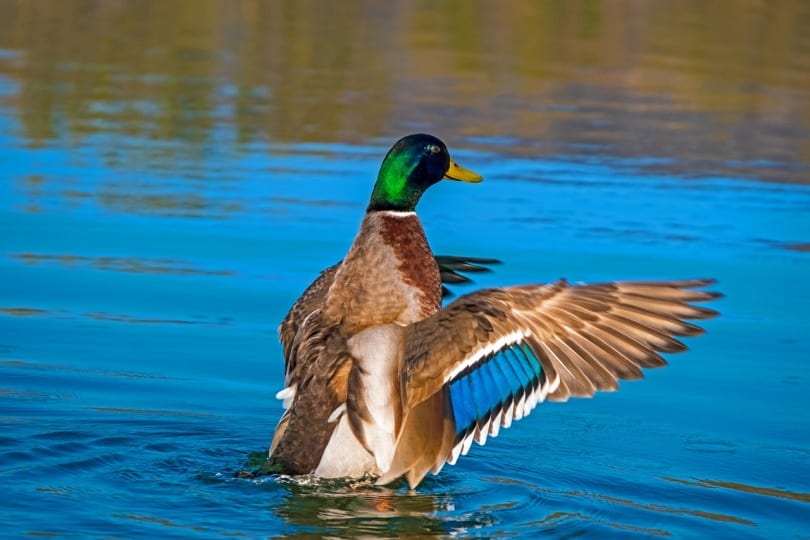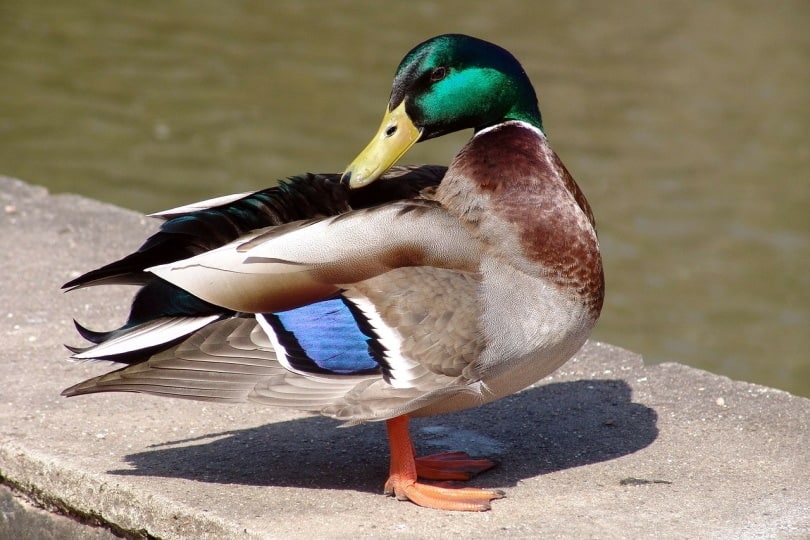If you frequently venture to your local park for a walk, you’ll be no stranger to Mallards. Mallards may have the largest population of any duck on the planet, according to National Geographic, and are the ancestors of many other domestic duck breeds.
Read on to find out more about these very distinctive ducks and whether or not it would be a good idea for you to start raising them.

Quick Facts About Mallard Ducks
| Breed Name: | Mallard Duck |
| Place of Origin: | Europe, Asia, North America |
| Uses: | Meat, eggs, pet |
| Drake (Male) Size: | 19.7–25.6 in, 1,000–1,300 g |
| Hen (Female) Size: | 19.7–25.6 in, 1,000–1,300 g |
| Color: | Iridescent green, black, blue, gray, brown, white, cream/buff (males), black, blue, brown, grey, white (females) |
| Lifespan: | 5–10 years |
| Climate Tolerance: | Various |
| Care Level: | Easy |
| Production: | Meat, eggs |
Mallard Duck Origins
Mallard Ducks have a very long history. As the world’s most plentiful duck breed, Mallards are spread far and wide and are native to Europe, North America, and Asia. They were first domesticated during the Neolithic Age in Southeast Asia, which was around 4,000 years ago. They were also commonly farmed for meat and eggs in both Europe and Asia.

Mallard Duck Characteristics
Mallards are somewhat large, plump, and heavy ducks. Their bodies are between 51 and 62 cm (19.7–25.6 in) in length and they typically weigh between 1,000 and 1,300 g. This goes for both males and females. Males and females are easily differentiated by their colors, which we’ll go into in more detail in “appearance.”
Mallards are what’s known as “dabbling ducks.” Dabbling ducks inhabit shallow waters and tip themselves upside down to feed in the water, with their rear ends sticking out at the surface. They also feed along the surface and typically target larvae, aquatic vegetation, insects, and small fish.
They tend to come as a pair, and females lay eggs in spring, between March and July. 8–13 eggs make up a clutch of Mallard eggs, and these are creamy, pale blue, or pale green in color. Mallards don’t lay many eggs per year, with the egg count averaging out at around 60 annually. Nesting Mallards build nests on the ground or in inconspicuous spaces for safety.
Mallards sometimes migrate, and sometimes don’t. If they do, they typically migrate to warmer climes in the Mediterranean, Middle East, Southern US, or Central America. Temperament-wise, calm and sociable but thrive best with other Mallards. Around humans, they tend to be reserved and are most friendly when they’ve been hand-reared from an early age.

Uses
Mallard Ducks have long been reared for their meat and eggs, which are sold both commercially and by small-scale farmers. Mallards are also a popular backyard pet for those with enough space to accommodate them, due to their quiet, calm temperaments and how easy they are to care for.
Appearance & Varieties
Drakes (males) are more eye-catching than females, with their shimmering green heads, white ring “necklace” around their necks, bright yellow bills, and brown/chestnut-colored breasts. Their wings are gray-brown and their rear ends are black, but with a few tail feathers bordered in white. Their speculum feathers are a startling blue with a purple tint.
Hens (females) also have blue, purple-tinted speculum feathers bordered in white, but their colors are more muted than those of drakes. Hens have light or dark brown (or a mix of both) mottled feathers and a brown stripe crossing their eyes. Their bills are yellow-black and less bright than those of drakes.
Hatchlings are born with yellow plumage dusted with black, have dark gray bills, and a striking black “eye line”, similar to hens but more obvious. Between 6 and 10 months of age, their plumage will either stay the same (females) or develop into the more shimmering, distinctive colors of a drake.

Population/Distribution/Habitat
Population-wise are in no danger of dying out anytime soon and are considered to be of the least concern by conservationists. This is because there are so many of them and the fact that they’re so widespread globally.
Mallards like shallow waters as these are easier for them to feed in and they can be found in both freshwater and saltwater and typically seek out ponds, rivers, lakes, and streams, but will pretty much go anywhere that suits their needs.
Mallards are omnivores, and their diet consists of a variety of things, including small fish, shellfish, invertebrates, grains, insects, berries, and plants.
Are Mallard Ducks Good for Small-Scale Farming?
Mallard ducks are a good choice for those who want to get started raising ducks on ranches, farms, or in a large and safe enough backyard. They may not be the most productive egg layers, but you can certainly enjoy the fruits of their seasonal laying periods if you’re a fan of fresh eggs.
In addition, they’re generally low-maintenance and are sure to put a smile on your face with their quiet chattiness and calming presence.
- See also: Hawaiian Duck
Featured Image Credit: AnnaER, Pixabay
